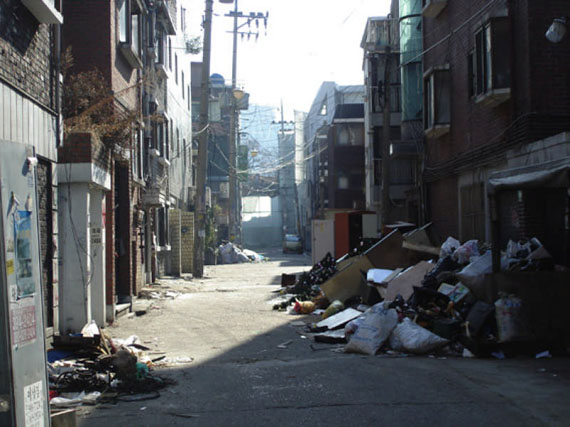
Haegue Yang »
Condensation
Light sculptures and video essays
Exhibition: 7 Jun – 22 Nov 2009
The Venice Biennale - Korean Pavilion
30124 Venezia
In the exhibition “Condensation”, presented at the Korean Pavilion of the 53rd Venice Biennale, Haegue Yang explores private or hidden spaces that might be considered marginal or insignificant but to the artist constitute profound backdrops for understanding: the vulnerable sites where informal development can occur.
The video essay Doubles and Halves—Events with Nameless Neighbors (2009) is a kind of cornerstone of the exhibition. In it, Yang integrates footage shot in two overlooked places—the declining neighborhood of Ahyun-dong, Seoul, where she used to live, and the seasonally abandoned Biennale grounds near the Korean Pavilion during the off-season. Juxtaposing a nonsynchronous voiceover with a lingering visual composition that features the residue of residents and their activities at these sites, the artist speculates on the invisible experience of disappeared inhabitants in order to consider the unwantedness and resonance of marginal spaces.
Consisting of a labyrinthine system of stacked venetian blinds flooded with natural light, Series of Vulnerable Arrangements—Voice and Wind (2009) evokes shadows of places and experiences not physically present. Here Yang uses commercially manufactured venetian blinds in indescribable, uncategorizable colors and patterns that exist at the edge of taste. These functional decorations for the home defy rigid concepts of design or periodization to emphasize the nonaesthetics of the private sphere. Six ventilators placed around the main gallery generate wind at various intervals, altering both the stability of the blinds as suspended barriers and the movement of visitors. Scent emitters infuse the installation with moments of sensory experience, calling upon the visitors’ subjectivity as a key element in the definition of the space.
In the sculpture Sallim (2009), Yang reproduces a full-scale model of her Berlin kitchen. Sallim (roughly translated as “running a household”) considers the noncommercial space of the kitchen as a site of preparation for action and the organization of life. Indebted to works such as Martha Rosler’s Semiotics of the Kitchen (1975) and other feminist practices of the 1960s and 1970s that insisted on the undervalued labor and potential of “women’s work,” Sallim unearths a potentially radical value in the domestic sphere of the kitchen as a space of “worklessness.”
�